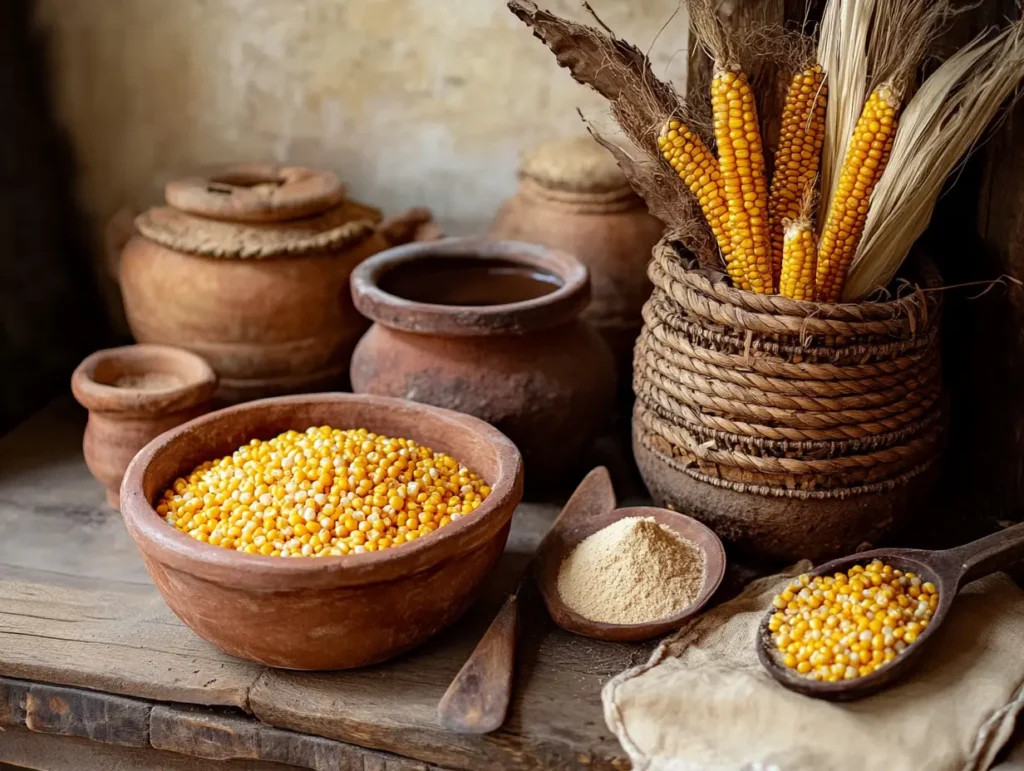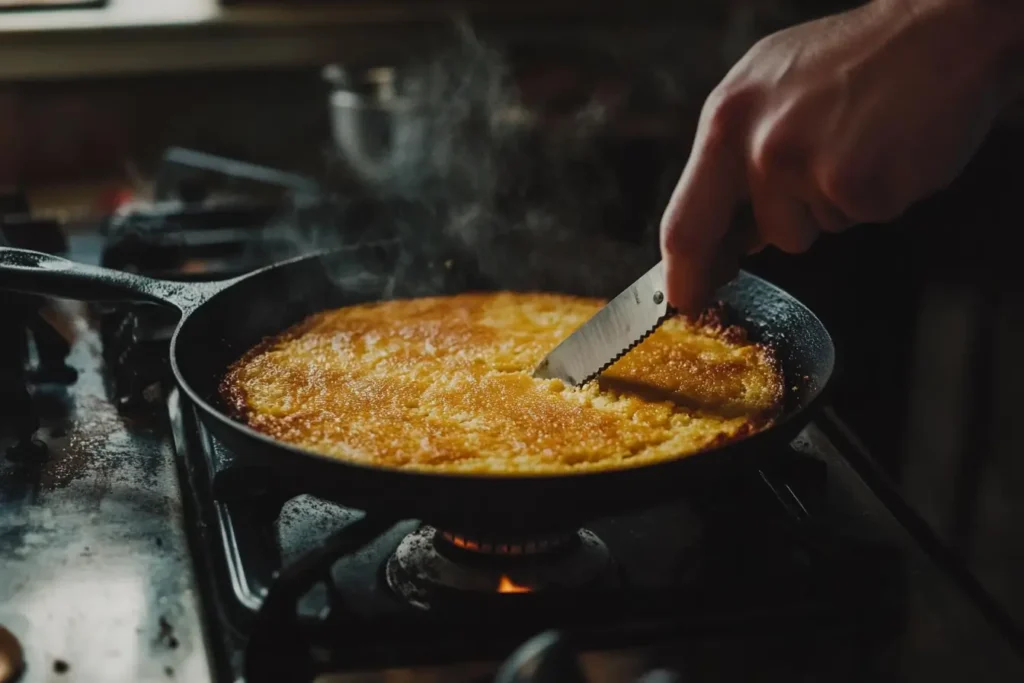Cornbread is one of the most beloved staples of Southern cuisine. But a contentious debate divides cooks across the country: Why do Southerners not put sugar in cornbread? For Southerners, the answer is rooted in tradition, culture, and practicality. Cornbread in its authentic form is a savory, simple dish—adding sugar changes its identity.
This article explores why Southerners do not put sugar in cornbread, delving into its historical origins, economic factors, and cultural significance. We’ll uncover how Southern cornbread differs from its Northern counterpart and why keeping it sugar-free preserves its authenticity.
Table of Contents
Historical Roots of Cornbread in the South
To understand why Southerners do not put sugar in cornbread, we must go back to its roots. Native Americans first introduced cornmeal as a staple ingredient, using it to create simple flatbreads with water and salt. These early recipes were savory by necessity, as sugar was not part of their diet. When European settlers arrived in the South, they adopted these recipes, crafting cornbread as a practical, affordable staple.
In the South, wheat flour was scarce, and corn grew abundantly. Cornbread became a cornerstone of meals, providing sustenance for families during times of hardship, such as the Civil War. These early versions of cornbread did not include sugar because it was expensive and considered a luxury item. This history explains why Southerners do not put sugar in cornbread, even today.

Economic and Social Factors Behind Sugarless Cornbread
The economic realities of the South played a significant role in shaping cornbread’s sugarless tradition. In the 19th century, sugar was a luxury item, accessible only to wealthy families. Most Southern households could not afford to use sugar liberally, reserving it instead for special occasions or desserts. Cornbread, a daily necessity, remained savory out of economic necessity.
Poverty in the South persisted well into the Reconstruction era, cementing the habit of preparing cornbread without sugar. Even after the abolition of slavery, African American communities adhered to these savory recipes, which had become deeply ingrained in their culinary practices. For many, cornbread symbolized resilience and resourcefulness, a way to make the most of what little they had.
Adding sugar to cornbread, particularly in the post-Civil War South, was often viewed as unnecessary extravagance. It clashed with the practical, no-frills ethos of Southern cooking. This cultural divide only deepened the distinction between Southern and Northern cornbread.
Transition in Milling Practices and Its Impact
For much of its history, cornmeal was stone-ground, a method that preserved the natural oils and nutrients of the corn. Stone-ground cornmeal had a coarser texture and a distinct, nutty flavor, which meant there was no need for added sugar to enhance its taste.
However, the industrialization of milling in the early 20th century changed everything. Steel-rolled milling replaced stone grinding, stripping cornmeal of its natural oils and flavor. The result was a finer, blander product that lacked the depth of traditional stone-ground meal. In response, some cooks began adding sugar to compensate for the loss of flavor, particularly in regions outside the South.
Despite this shift, many Southerners resisted the trend. For them, sugarless cornbread wasn’t just a matter of taste—it was a statement of identity and heritage. Today, the resurgence of stone-ground cornmeal, thanks to artisanal milling practices, has reignited interest in traditional cornbread recipes.
Southern Cornbread vs. Northern Cornbread
The differences between Southern and Northern cornbread are stark, reflecting regional variations in ingredients, preparation methods, and cultural attitudes.
Southern cornbread is savory, dense, and made with white cornmeal, buttermilk, and sometimes bacon grease. The batter is poured into a preheated cast iron skillet, creating a crispy, golden crust that’s iconic in Southern cuisine.
Northern cornbread, on the other hand, tends to be sweeter, fluffier, and more cake-like. It often includes yellow cornmeal, sugar, and more wheat flour, resulting in a lighter texture. While Southerners view cornbread as a savory side dish to complement rich meals like chili or fried chicken, Northerners may see it as a standalone snack or dessert.
For many Southerners, sweet cornbread simply doesn’t belong on the table. It’s considered an unnecessary deviation from a tradition that values simplicity and authenticity.
The Cultural Identity of Southern Cornbread
Cornbread is more than a dish in the South; it’s a cultural symbol. It represents the ingenuity and resilience of generations who relied on simple, accessible ingredients to feed their families. The preparation of cornbread is steeped in ritual, from seasoning the cast iron skillet to carefully measuring the cornmeal.
This cultural significance is celebrated at events like the National Cornbread Festival in Tennessee, where traditional recipes take center stage. These gatherings underscore the deep connection Southerners feel to their savory cornbread, which stands as a testament to their heritage and resourcefulness.
Native American Influence on Cornbread Recipes
Southern cornbread owes much of its history to Native American cooking. Indigenous tribes were the first to grind corn into meal, using it as the base for simple, nourishing bread. Early cornbread recipes, often referred to as “corn pone,” featured just cornmeal, water, and salt. These savory breads were baked over open flames or in clay ovens, offering a glimpse into the resourceful cooking methods of Native communities.
When settlers adopted these practices, they added their own touches, like using bacon grease or buttermilk. However, the core simplicity of the recipe remained unchanged, reflecting its Native American roots.
Revival of Traditional Cornmeal

In recent years, there’s been a resurgence of interest in traditional stone-ground cornmeal. Artisanal mills across the South are bringing back heirloom varieties, offering cornmeal with the rich flavor and texture that industrialized milling lost.
Using stone-ground cornmeal isn’t just a nod to the past—it’s a way to elevate the flavor of cornbread while staying true to its roots. For cooks seeking authenticity, this revival offers an opportunity to experience cornbread as it was meant to be: savory, flavorful, and satisfying.
The Role of Cast Iron in Cornbread Tradition
No discussion of Southern cornbread would be complete without mentioning the cast iron skillet. A well-seasoned cast iron pan is essential for achieving the perfect crust—a crispy, golden layer that adds texture and depth to every bite.
Preheating the skillet is crucial. When the batter is poured into the hot pan, it creates an immediate sizzle, forming the iconic crust that defines Southern cornbread. For many cooks, the cast iron skillet is as much a part of the tradition as the cornbread itself.
Recipe Tips for Authentic Southern Cornbread
For those who want to make Southern cornbread at home, authenticity starts with the ingredients.
- Ingredients:
- 2 cups white cornmeal
- 1 cup buttermilk
- 2 eggs
- 2 tablespoons bacon grease or butter
- Instructions:
- Preheat your oven to 425°F with a cast iron skillet inside.
- In a bowl, mix the cornmeal, buttermilk, eggs, and bacon grease until smooth.
- Pour the batter into the hot skillet and bake for 20-25 minutes, or until golden brown.
This simple recipe captures the essence of Southern cornbread—savory, hearty, and true to tradition.
The Sweet Cornbread Controversy

The debate over sugar in cornbread is more than just a culinary disagreement; it’s a reflection of regional identity. For Southerners, adding sugar feels like an affront to tradition, a step toward turning a beloved side dish into something unrecognizable.
While some argue that sugar enhances the flavor, purists maintain that authentic Southern cornbread should be savory. The divide persists, but one thing is clear: for many Southerners, cornbread without sugar isn’t just a recipe—it’s a way of life.
Cornbread as a Comfort Food
Cornbread holds a special place in the hearts of Southerners. It’s more than a side dish; it’s a connection to family, tradition, and home. Whether paired with collard greens, crumbled into buttermilk, or served alongside chili, cornbread is a comforting reminder of the past. Its versatility and simplicity make it a cornerstone of Southern cuisine, offering warmth and nostalgia with every bite.
Conclusion: A Slice of Southern Tradition
Cornbread, in its simplest form, is a celebration of Southern resilience and ingenuity. By resisting the temptation to add sugar, Southerners honor a tradition that values practicality and authenticity. Whether you’re a lifelong Southerner or a curious cook, embracing the savory essence of cornbread is a delicious way to connect with a rich culinary heritage.
For more tips and traditional recipes, Dive into the ultimate guide to traditional cornbread recipes.
FAQs
Do Southerners put sugar in their cornbread?
Traditionally, no. Southerners prefer their cornbread savory, reflecting its roots as a practical and affordable staple.
Can I put sugar in my cornbread?
You can, but it’s not considered authentic Southern cornbread. Sweet cornbread is more common in Northern recipes.
What is the difference between New York cornbread and Southern cornbread?
New York cornbread is often sweet and cake-like, using yellow cornmeal and sugar. Southern cornbread is savory, dense, and made with white cornmeal.
Is cornbread not supposed to be sweet?
Traditional Southern cornbread is not sweet. Its flavor relies on quality ingredients like buttermilk and bacon grease rather than sugar.

